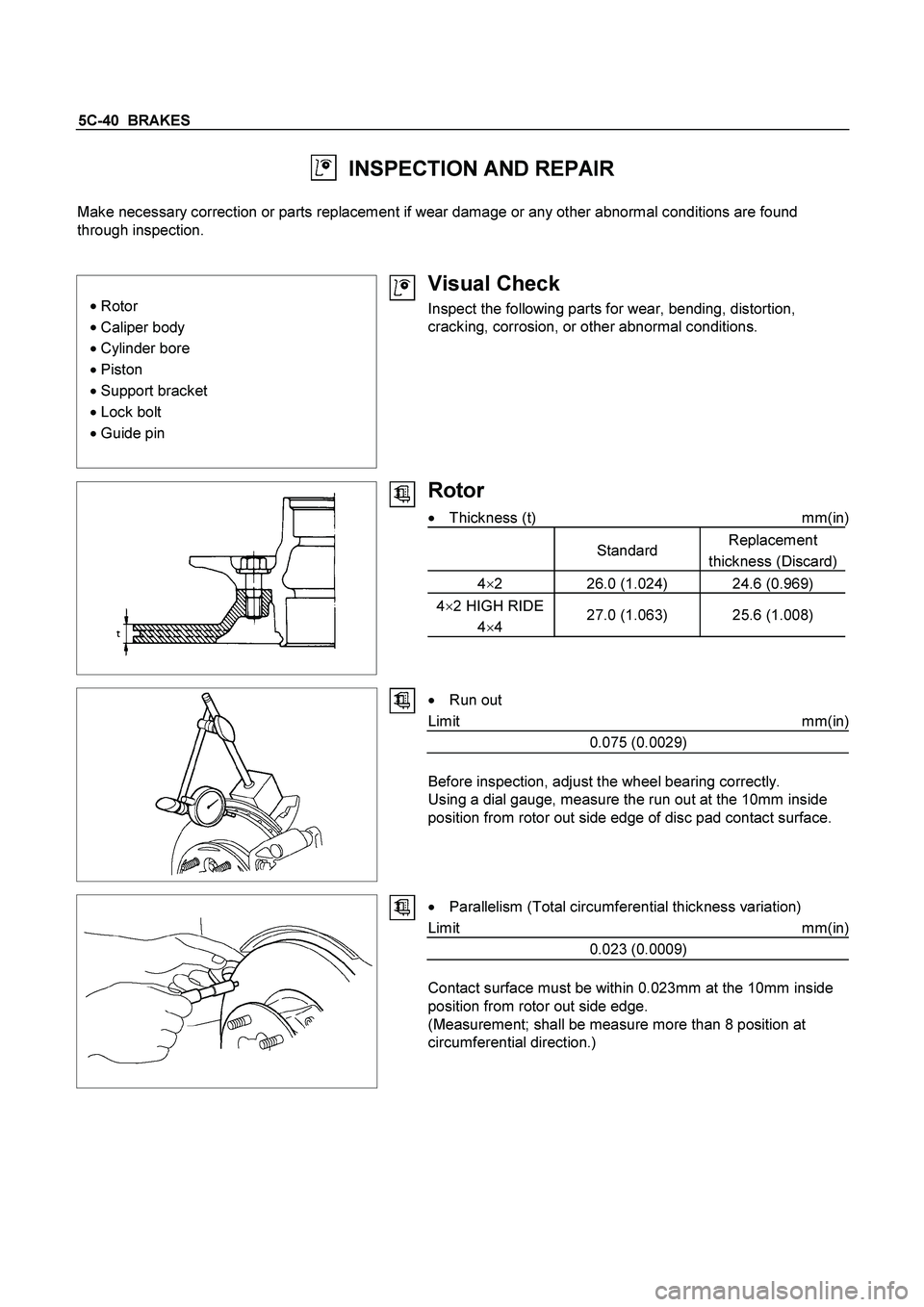Page 459 of 4264
BRAKES 5C-33
FRONT BRAKE ASSEMBLY
REMOVAL AND INSTALLATION
Removal Steps
�
1. Brake flexible hose
�
2. Lock bolt
� 3. Pad assembly
4. Clip; pad
5. Caliper assembly
� 6. Support bracket
�
7. Front hub and disc assembly
Installation Steps
�
7. Front hub and disc assembly
�
6. Support bracket
5. Caliper assembly
�
4. Clip; pad
3. Pad assembly with shim
� 2. Lock bolt
�
1. Brake flexible hose
Page 460 of 4264
5C-34 BRAKES
Important Operations - Removal
1. Brake Flexible hose
Remove the bolt and gasket and disconnect the brake flexible
hose from the caliper.
After disconnecting the flexible hose, cap or tape the openings
to prevent entry of foreign material.
2. Lock Bolt
Remove the lock bolt from the caliper.
3. Pad Assembly with Shim
Rotate the caliper upward.
Mark the lining locations if they are to be reinstalled.
Page 461 of 4264
BRAKES 5C-35
6. Support Bracket
Take care not to damage the flexible brake hose when
removing the support bracket.
7. Front Hub and Disc Assembly
For the removal procedure, refer to Section 4C "FRONT
WHEEL DRIVE".
Important Operations - Installation
7. Front Hub and Disc Assembly
For the installation procedure, refer to the front hub and disc
reassembly procedure in Section 4C "FRONT WHEEL
DRIVE".
Page 462 of 4264
5C-36 BRAKES
6. Support Bracket
Torque N�m(kgf�m/lb�ft)
196 - 235 (20.0 – 24.0 / 145 - 174)
Set up the clip and pad before installation of the support
racket.
4. Clip ; Pad
Install new parts if necessary.
2. Lock Bolt
Torque N�
m(kgf�
m/lb�
ft)
32 - 40 (3.3 – 4.1 / 24 - 30)
1. Brake Flexible Hose
Attach the bolt and new gasket
Torque N�m(kgf�m/lb�ft)
29 -39 (3.0 - 4.0 / 22 - 29)
After installation, bleeding and replenishing procedure must be
performed.
Wipe the circumference of the hose clean.
Note:
�
�� �
Always use new gaskets.
�
Be sure to put the hooked edge of the flexible hose end into
the anti-rotation cavity.
Page 463 of 4264
BRAKES 5C-37
REMOVAL AND INSTALLATION OF DISC PAD
Removal Steps
1. Lock Bolt
Remove the lock bolt from the caliper.
Note:
Don't remove the brake hose from caliper when replacing
pads.
2. Rotate the Caliper Upward
Remove the caliper from the support bracket and the caliper to
the upper link or the frame.
Note:
While caliper is removed from support bracket, never step
on the brake pedal or the piston will protrude rapidly.
3. Pad Assembly with Shim
Remove the pad assembly with the shim.
Mark the pad locations if they are to be reinstalled.
4. Clip ; Pad
Discard the used clip and install a new one.
Installation Steps
1. Clip ; Pad
2. Pad Assembly with Shim
After attaching the pad assembly with the shim to the support
bracket, position the wear indicator to the lower side of the
inner pad and position the wear indicator to the upper side of
the outer pad.
Page 464 of 4264
5C-38 BRAKES
3. Caliper Assembly
Lower the caliper into its original position.
Do not damage the flexible hose by twisting or pulling it.
4. Lock Bolt
Attach the lock bolt to the caliper.
Torque N�m(kgf�m/lb�ft)
32 - 40 (3.3 – 4.1 / 24 - 30)
Page 465 of 4264
BRAKES 5C-39
DISASSEMBLY
CALIPER ASSEMBLY
Disassembly Steps
1. Bleeder with cap
� 2. Piston
3. Dust seal; piston
4. Ring seal
5. Body; caliper
Important Operations
2. Piston (with Ring Seal)
Insert a block of wood into the caliper and force out the piston
by blowing compressed air into the caliper at the flexible hose
attachment.
This procedure must be done prior to removal of dust seal.
CAUTION:
Do not place your fingers in front of the piston in an
attempt to catch or protect it when applying compressed
air.
Page 466 of 4264

5C-40 BRAKES
INSPECTION AND REPAIR
Make necessary correction or parts replacement if wear damage or any other abnormal conditions are found
through inspection.
�
Rotor
�
Caliper body
� Cylinder bore
�
Piston
�
Support bracket
�
Lock bolt
�
Guide pin
Visual Check
Inspect the following parts for wear, bending, distortion,
cracking, corrosion, or other abnormal conditions.
Rotor
� Thickness (t) mm(in)
Standard Replacement
thickness (Discard)
4�
2 26.0 (1.024) 24.6 (0.969)
4�
2 HIGH RIDE
4�4 27.0 (1.063) 25.6 (1.008)
� Run out
Limit mm(in)
0.075 (0.0029)
Before inspection, adjust the wheel bearing correctly.
Using a dial gauge, measure the run out at the 10mm inside
position from rotor out side edge of disc pad contact surface.
�
Parallelism (Total circumferential thickness variation)
Limit mm(in)
0.023 (0.0009)
Contact surface must be within 0.023mm at the 10mm inside
position from rotor out side edge.
(Measurement; shall be measure more than 8 position at
circumferential direction.)